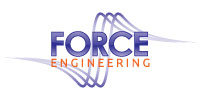
WHY USE LINEAR
INDUCTION MOTORS?
HOW LINEAR INDUCTION
MOTORS WORK
LINEAR INDUCTION MOTOR (LIM) OPTIONS
LINEAR INDUCTION
MOTORS CONTROLS
RECOMMENDED READING
FAQ
Linear Induction Motor Options
When selecting a Linear Induction Motor (LIM) it is important to understand the interaction between stator, reaction plate and airgap. The variety of designs suited to different speeds, airgaps and reaction plates is extensive.
LIMs are most often applied to situations where standard drive solutions fail to meet customer requirements. Force Engineering has an experienced and skilled design team who develop customized solutions that meet all customers' requirements. Some of the more common design options are outlined below.
Power Supply
The available power supply is an important consideration for all motors, and plays a large part in determining possible motor characteristics.
LIMs can be designed to operate at a wide range of Frequency/Voltage, including all worldwide supply voltages & frequencies. Although 3 phase supply is more common, single phase motors can also be developed and can produce force of up 600N. LIMs can be driven directly from a utility supply, or power conditioning equipment such as inverters may be used to improve system control and efficiencies. Motors can be connected in Star/Wye or Delta or all leads may be brought out to allow the customer flexibility in connection. A variety of connector plugs or sockets can be fitted in-house to meet the chosen requirement.
Duty Cycle
This simply defines how often a motor will be operating during a defined period of time. For instance, a machine operating for only a few seconds per minute maybe capable of much greater output power than a machine designed to operate continuously.
To give a longer duty cycle or increase output power in a given time, various forms of cooling may be employed. These range from simple passive heat sinks to forced air or water cooled machines offering a cooling factor of up to 6 times greater than passive air.
Environmental Protection
LIMs can operate in a wide range of environments, from cleanrooms and sterile medical environments to foundries and even the vacuum of space. In order to meet the protection needs for an application, Force has developed a range of motor protection systems depending on customer requirements. These range from vacuum impregnation varnishing, through epoxy resin encapsulation to hermetically sealing motors in stainless steel cans rated up to IP69 standard.
Thermal Protection
As well as linear drive machines, force can also produce machines to provide different forms of motion. These include curved motors, faceplate type drives and tubular motors.
Quality and Approvals
All motors are made to CE standards using top grade materials. Each motor is extensively tested during manufacture to ensure a consistently high quality product. Force also has UL certification, and can produce machines as UL recognised components.
Topology
As well as linear drive machines, force can also produce machines to provide different forms of motion. These include curved motors, faceplate type drives and tubular motors. Example images of some of the various topologies are shown below.
Physical Dimensions
The overall area available for the Linear Induction Motor drive is an important characteristic, as this determines the size and possible output power of motors that will fit within the system. Motors can be designed to a wide range of physical dimensions, all to tight mechanical tolerances and to meet unusual dimensional requirements such as very narrow or low height machines.
A Linear Motor system may be single or double sided. In general terms, single sided systems are mechanically simpler and take up less space on the stator side whereas double sided systems can give an improved performance and reduce vehicle weight. With either system, an important feature is the mechanical clearance between the reaction plate and the stators, determined to a large extent by the mechanical tolerances of the moving part.
A range of reaction plate materials including copper, copper alloys, various grades of aluminium or even steel may be used dependant on requirements. Alternatively the object to be moved can itself be used as the reaction plate, in applications such as scrap sorting or the movement of steel sections.
Moving Stator or Moving Rotor
With a Linear Induction Motor drive system, the powered stator can be mounted either on the moving part or on the stationary part. This is to a large part dependant on the application. For instance, a customer may require simple unpowered vehicles with a series of powered stators mounted on a track (a configuration commonly seen in amusement rides and baggage handling). Alternatively, the vehicles may include the powered stators, allowing for a very simple and cheap track (often seen in transport systems).
Force and Speed
Linear Induction Motors can be developed to meet a wide variety of force and speed criteria. Motors can be designed to produce a specified force at a given speed. Alternatively, they can be developed to accelerate a vehicle of given mass to a set velocity within a certain time or to produce a force without movement.
Speed control can be implemented in several ways, from on/off switching to closed loop inverter control. Speed feedback systems can be included in the system to give fine control of system speed.
